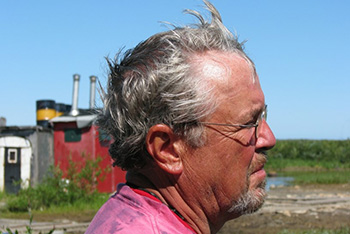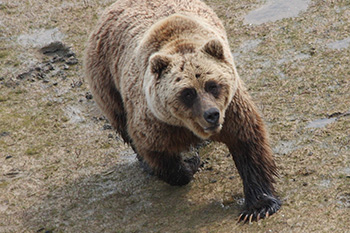Dr. Robert Rockwell
Wapusk National Park
Wapusk National Park brings eager researchers from all over, and one of those with decades of time in the park hails from, of all places, Missouri’s Ozark Mountains.
Dr. Robert “Rocky” Rockwell has long held an interest in the North. As the Vietnam War raged, Dr. Rockwell crossed the border to study Ecology at Queen’s University in Kingston, Ont., eventually earning a PhD.
It was at Queen’s that he was first introduced to snow geese.
Dr. Rockwell returned to the United States after accepting two positions: Professor of Ecology at the City University of New York and a research associate at the American Museum of Natural History.

© Dr. Robert Rockwell
However, the wild kept calling and in 1969, he opted to continue research work with a strong desire to study snow geese in a manageable situation.
“There is a certain nobility to male and female snow geese,” Dr. Rockwell said.
After multiple transfers on various modes of transportation, Dr. Rockwell and his students journeyed to La Pérouse Bay, near Churchill. However, their team required local expertise, which prompted a relationship with Danny, a local Dene man, and a few of his friends who knew the vast wilderness well.
The following day, the small team was strapping down all the equipment to the qamuitiiiks, and in single file, the snowmobiles navigated the blanket of white, flat terrain. Trees rose and fell on the horizon.
Upon arrival at camp, Danny’s grandfather was there to meet the team. Being an outsider, Dr. Rockwell asked him, “what is your advice for me?” Danny’s grandfather replied, “The advice is simple. White men think they know everything; you don’t know anything. You sit on a rock and learn from nature.”
This philosophy has been the hallmark of Dr. Rockwell’s research. He confesses to sitting on a lot of rocks and observing.
“Too many of us go into doing field biology, thinking we already know the answer, when we don’t. Only the animals and environment know the answers.”
First observations
One of the most intriguing thing about snow geese is the female is the one that sits on the eggs, and unlike ducks and many other birds, the male doesn’t leave upon insemination. It stays to guard her and the nest.
“I’ve seen male snow geese chase away arctic foxes, caribou and even a wolf. One male was so daring it flew up and started smacking a polar bear, who was trying to eat the eggs, upside the head,” Dr. Rockwell said.
The mother sits on the nest for 24 days. Upon hatching, they leave the nesting area to a beautiful feeding flat, which has lots of teeny tiny graminoids, or grasses. The mother goose loses a lot of weight in 24 days, so she will need to replenish herself.
Males have an active role. The male circles his feeding family while scanning the sky in search of aerial predators. If one approaches, the male makes noise to alert the colony, and other males make noise in attempts to ward off predators. This cycle is repeated until everybody gets their flight feathers, and they can fly south together.
Males are 20 per cent larger than females and can be nasty. Armed with a serrated beak, they pinch and twist your skin as a defence mechanism.
“I’ve got permanent scars on my arms from some,” Dr. Rockwell noted.
Changes in the park
Dr. Rockwell recalls his first trip to Wapusk National Park in 1969, 27 years before it was incorporated as a national park in 1996: “We had to rough it,” he said.
The team slept in tents with guns on their chests, as there was no barrier between them and the wildlife.
“It was really scary. There are all sorts of noises: some of them animals, some are people snoring!” Dr. Rockwell recalled. “Basically, you didn’t get very good sleep, and so, people would take naps during the daytime when somebody else was up and could see.”
The first electrical fence was installed in 1974, which has advanced over the years. Due to climate change, the permanent research facilities have had to undergo modifications.
“The ice starts breaking up and in Hudson Bay we get tidewater coming in. And so, you start getting water in the buildings. So, all the buildings are now up four feet off the ground,” Dr. Rockwell said.
In addition to climate change, there were wildlife changes, as grizzly bears made their way through Wapusk National Park. Anytime a new species is introduced, it affects the ecosystem.
Five years ago, there were 75,000 snow geese nesting pairs, and now there are only around 1,500, partly due to climate and habitat changes, but largely because of grizzly and black bears eating the eggs.
Currently, the birds are flying further north, in regions Dr. Rockwell’s field team has yet to locate.
Close encounters
While working in such extreme terrains and conditions, the array of wildlife encounters can be both mesmerizing and alarming. Dr. Rockwell detailed a grizzly bear encounter that he will remember for a lifetime.
Dr. Rockwell grew up on a dairy farm, so his exposure to working with animals in close proximity was routine.
However, Dr. Rockwell recalls a time shortly after Wapusk was designated as a National Park, when he and his student were lying in the grass while taking pictures of a goose in a nest 25 feet away. Hyperfocused on taking pictures of the nest, Dr. Rockwell felt his student poking his shoulder.

© Dr. Robert Rockwell
It was a male grizzly. He proceeded to flop down and eat all the eggs.
With a racing heart, the student asked if they should run, but Dr. Rockwell insisted they hold their position and use their guns and fire in the air in case they needed to scare the grizzly away.
The grizzly stood up, looked at the pair and then turned and waddled away.
“When he turned, I knew we were fine. He was on an egg hunt.”
If grizzlies get a taste for eggs during that incubation period, they will travel from nest to nest to satisfy their cravings.
Though Dr. Rockwell officially retired in May 2022, he still continues his research program.
“People ask me why I am still doing this after 50 years, but it is because I have incredible experiences like that every year,” he said.
- Date modified :